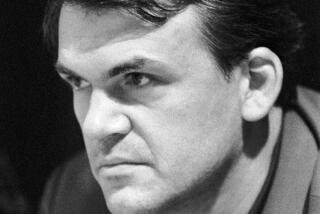An inaccurate yet skillful recount
- Share via
OF the trio of essayists from the Romantic era whose work regularly turns up in anthologies -- William Hazlitt, Thomas de Quincey and Charles Lamb -- Lamb is probably the most remote to modern tastes. Hazlitt’s lively, direct prose and probing intelligence give him the greatest appeal, while de Quincey’s strange yet subtle and sensitive writings, notably “Confessions of an English Opium-Eater,” have a power all their own.
Lamb’s effusive style and the topics he chose to embroider upon (e.g., “Old China,” in this case, not the ancient Middle Kingdom of Asia, but antique porcelain) are not immediately inviting to many readers today. In his own time, however, Lamb was a much-loved figure, what the English call a “clubbable” fellow -- convivial, affable, fond of a drink, numbering among his friends Wordsworth and Coleridge, this, despite the fact that unlike those two great Romantic champions of Nature, Lamb detested the countryside and loved his native London. The work that probably gained him the most fame was one he cowrote with his sister Mary, “Tales From Shakespeare,” a charming collection of stories retelling the plays in a delightfully engaging manner designed to appeal to children.
But alongside this pleasantly quaint image of a talented pair of literature-loving siblings, there is the dark and troubling shadow -- no, more than shadow -- reality of matricide. In 1796, during one of the fits of insanity that continued to plague her all her life, the 31-year-old Mary stabbed and mortally wounded her mother. The authorities -- and jury -- back then were surprisingly sympathetic (perhaps more so than they might be today). After three years in a sanatorium, Mary was released into the care of her brother, who continued to look after her for the rest of his life, never marrying. Although most of the time Mary was sane, intelligent, even sociable, when she sensed a bout of her illness coming on, she and her brother would walk hand-in-hand, weeping, to commit her to the asylum until her next period of recovery.
Preexistent insanity and the strain of looking after ailing parents are among the circumstances generally adduced to account for Mary’s rash deed, but clearly there is room for a novelist to imagine other possible factors as well. And who better than Peter Ackroyd, the author of such widely praised historical novels as “The Last Testament of Oscar Wilde,” “Hawksmoor,” and “The Clerkenwell Tales,” not to mention his nonfiction “biography” of London, the teeming, history-soaked metropolis that figures so prominently in the Lambs’ story.
Considering Ackroyd’s long fascination with the motives of literary forgers, perhaps we shouldn’t be surprised to find that, along with Mary Lamb, the most prominent character in this book is not her brother Charles, but a young man around his age who forges Shakespearean manuscripts. The son of a London bookseller, William Ireland (1777-1835) is not an Ackroyd invention but a real-life character whose ingenious imitations (including three previously “undiscovered” full-length plays) fooled some of the most knowledgeable Shakespeareans of his day. Ireland was just 17 when he began producing these remarkable simulations, and Ackroyd imagines the sensitive but innocent Mary falling for forgeries and forger alike.
Few writers are more adept than Ackroyd at evoking and explaining the lure of the historical past. For Mary, harassed by the demands of caring for her parents, the past provides a refuge: “To dwell in another time -- if only for a moment -- offered her proof that she need not be confined or constricted.”
While Mary is being drawn to William Ireland and his “Shakespearean” manuscripts, another brilliant, struggling youth comes to London and enters the Lambs’ orbit: de Quincey. In contrast to Charles, who is somewhat disdainful of Ireland (the son of a mere tradesman) and rather obtuse about the depth of his sister’s feelings, de Quincey quickly grasps what is happening and tries to explain it to Charles. Ackroyd’s portrait of de Quincey is wonderfully perceptive and poignant. All the more reason, however, that the reader will be dismayed to learn that the real de Quincey (1785-1859), did not come to London until he was 17, well after the time that the events in this novel occur. (At the time that Mary killed her mother, he would have been no more than 11!)
And herein lies the chief problem with this otherwise enjoyable, beautifully written book. Yes, it is labeled “a novel,” and the author duly warns us that he has “invented characters and changed the life of the Lamb family for the sake of the larger narrative.” But there’s a difference between invented characters and events which might possibly have existed and which illuminate hidden motives and inventions blatantly at odds with generally known facts. Readers who are knowledgeable about the Lambs and their era will find it hard to lend credence to a historical novel that contradicts what they know. And readers who know little about the subject are being shortchanged, for even if one has no right to expect a historical novel to be as accurate as a history book, one has some expectation of learning something about the subject from it and that the story will be, if not wholly accurate, then at least not flagrantly inaccurate. Surely, from a writer as steeped in English history as Ackroyd, we might have expected a higher level of verisimilitude. At the very least, he could have followed the example of Philip Roth, who unlike Ackroyd is not a historian, but who furnished readers of “The Plot Against America” with a postscript giving solidly informative accounts of the real-life historical figures who play such decidedly different roles in his novel. Imaginative invention and historical accuracy can indeed coexist.
Merle Rubin is a critic whose work has appeared in several
publications, including the Wall Street Journal and the Christian Science Monitor.
More to Read
Sign up for our Book Club newsletter
Get the latest news, events and more from the Los Angeles Times Book Club, and help us get L.A. reading and talking.
You may occasionally receive promotional content from the Los Angeles Times.










